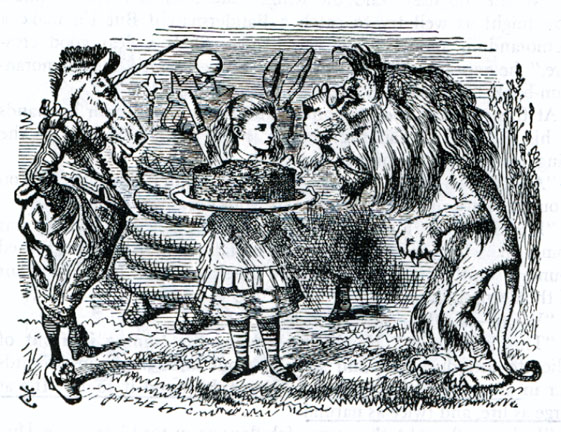
Sharing the cake between the Lion and the Unicorn, by Sir John Tenniel. Wood-engraving by Dalziel. Illustration for the seventh chapter of Lewis Carroll's Through the Looking Glass (1871). The pun on "Lion" in both the character's name as well as in the words "lion's share of the cake" is another example of the wordplay found throughout the tale. There is an inherent irony in the portrayal of majestic animals such as the Unicorn and Lion squabbling over a piece of cake.
In 2000 student assistants from the University Scholars Program, National University of Singapore, scanned this image and added text under the supervision of George P. Landow. [You may use this image without prior permission for any scholarly or educational purpose as long as you (1) credit the site and (2) link your document to this URL in a web document or cite the Victorian Web in a print one.]
Commentary by Ray Dyer
Tenniel's final portrayal of the nursery-rhyme characters carries their political associations further. There is a paradox here: the rhyme traditionally presents the Lion as the victor, whereas here Tenniel depicts him as ragged and exhausted; on the other hand, the Unicorn appears quite self-assured, well-groomed and debonair. This becomes more extraordinary when we find Hatta telling the King that each of the rivals had "been down," remarkably, about eighty-seven times and that this had created "such a cloud of dust." Carroll, it seems, has not for the first time turned "contrariwise," and has instructed his artist to reverse the traditional outcome of the famous encounter. At the literary level also, Carroll makes this quite clear, as the Unicorn is described as casually sauntering by, with hands in pockets, and declaring that he "had the best of it this time." Curiouser and curiouser, as Alice might have said.
Patriotic Victorians such as Carroll and Tenniel are unlikely to have been mobilising partisanship either for or against either England or Scotland at the national level. Carroll, however, had a satirical bent. By 1870 he had aimed a number of biting satires at persons he knew and had dealings with, including the venerable "D. D.s" or Doctors of Divinity of his Christ Church college (Collingwood, 40-124; Wakeling, The Oxford Pamphlets). It seems that he had a different target in mind here — one in the political arena.
Carroll took a keen interest in parliamentary matters, and regularly deployed his somewhat privileged franchise of the vote, in both college elections and national ones. When visiting London he occasionally went to "the House" at Westminster, to watch the late-night debates from the public gallery, as on Friday 3 and Friday 24 April 1868 (Diaries 6: 12, 28). On such occasions he had met such prominent members of the House as the then Chancellor of the Exchequer, George Ward Hunt. The great political protagonists of the day were undoubtedly Benjamin Disreali and William Ewart Gladstone. Carroll certainly watched their debates in 1868. Whilst Gladstone as a Liberal held the Oxford seat, Disraeli as a Young Conservative had largely helped the ageing Lord Derby with his 1867 Reform Act, which widened the franchise of the vote — a matter close to Carroll's heart. One of Carroll's satirical pieces at this time was the anagram and anti-Gladstone tilt, "A wild man will go at trees" (65, n.93), from "William Ewart Gladstone." Carroll also favoured anagrams by others, including "I lead, Sir!" from "Disraeli" (65).
In short, the Tenniel drawing above may well illustrate Carroll's political preference for Disraeli, in the guise of the dandified and victorious Unicorn, over Gladstone (known for chopping logs and suchlike at his rambling country estate), in the guise of the rougher, exhausted Lion.
In his last children's story Carroll would provide further political parodies, with forays around "Political Dichotomy," "Obstructionism," "British Pride" and, not to forget his pet hate, "War." While these are later delivered in the voice of his aged avatar "Mein Herr," Carroll's literary dexterity also allowed him to take a subtler, more oblique, less strident approach — allowing the canny reader to pick up the references. As the Narrator in his later work remarks so astutely, "I thought it best to say nothing" (Sylvie and Bruno Concluded, Ch. XIII).
Related Material
Bibliography
Carroll, Lewis. Sylvie and Bruno Concluded. London: Macmillan, 1893.
_____ . Lewis Carroll's Diaries. The Private Journals of Charles Lutwidge Dodgson. Vol. 6. Ed. Edward Wakeling. England: Lewis Carroll Society, 2001.
_____. The Oxford Pamphlets, Leaflets and Circulars of Charles Lutwidge Dodgson. Ed. E. Wakeling. Virginia: University Press, 1993.
Collingwood, Stuart D. The Lewis Carroll Picture Book. London: Fisher-Unwin, [1899] 1961. [The work in question, reproduced here, was Carroll's acerbic and humorous collection of short pieces, c.1865-1874, under the alias of "An Oxford Chiel" or "fellow." See Notes By An Oxford Chiel. Oxford: James Parker & Co., 1874. The collection together with other similar pieces was later republished by Wakeling in Carroll, 1993.]
Wakeling, Edward, Ed. (See Carroll, 1993).
Last modified 20 July 2021